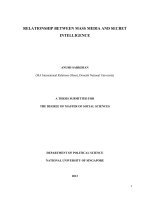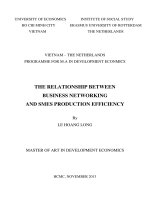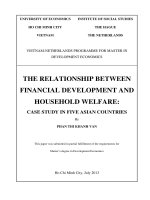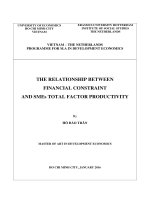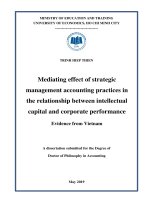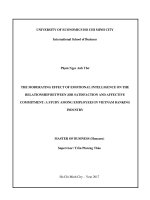The relationship between training perception and employee engagement impacts of perception of reward and self efficacy
Bạn đang xem bản rút gọn của tài liệu. Xem và tải ngay bản đầy đủ của tài liệu tại đây (465.59 KB, 86 trang )
VIETNAM NATIONAL UNIVERSITY
VIETNAM JAPAN UNIVERSITY
HOANG VU DUONG
THE RELATIONSHIP BETWEEN
TRAINING PERCEPTION AND
EMPLOYEE ENGAGEMENT: IMPACTS
OF PERCEPTION OF REWARD AND
SELF-EFFICACY
MASTER THESIS
BUSINESS ADMINISTRATION
Hanoi, 2019
VIETNAM NATIONAL UNIVERSITY
VIETNAM JAPAN UNIVERSITY
HOANG VU DUONG
THE RELATIONSHIP BETWEEN
TRAINING PERCEPTION AND
EMPLOYEE ENGAGEMENT: IMPACTS
OF PERCEPTION OF REWARD AND
SELF-EFFICACY
MAJOR: BUSINESS ADMINISTRATION
CODE: 60340102
RESEARCH SUPERVISORS
DR. TRAN HUY PHUONG
ASSOC. PROF. KODO YOKOZAWA
Hanoi, 2019
ACKOWLEDGEMENT
First of all, I would like to express my sincere gratitude to Dr. Tran Huy Phuong and
Assoc. Prof. Kodo Yokozawa, who are my supervisors, for their guidance,
encouragement and useful comments on my master thesis. These considerably help
me in completing this research work.
I also would like to say thank to Vietnam Japan University and all lecturers here,
especially in program of MBA, for giving me opportunity to study and experience
in international and academic environment, which provides me valuable knowledge
both theoretically and practically.
Furthermore, I want to thank all staffs of VJU, especially Ms. Huong of from MBA
program, for greatly supporting me during 2 years studying.
Last but not least, I want to express my gratitude to all of my friends, especially Ms.
Nguyen Huyen Trang and Ms. Nguyen Thi Ngoc Anh for their help and
encouragement, which academically and mentally support me at any difficult time.
Sincerely,
Hoang Vu Duong
TABLE OF CONTENTS
LIST OF FIGURES
LIST OF TABLES
LIST OF ABBREVIATION
CHAPTER 1: INTRODUCTION.............................................................................. 1
1.1. Research motivation..................................................................................... 1
1.2. Research objectives...................................................................................... 2
1.3. Research scope and objects.......................................................................... 3
1.4. The structure of the paper............................................................................. 3
CHAPTER 2: LITERATURE REVIEW................................................................... 4
2.1. Employee engagement................................................................................. 4
2.2. Employee training...................................................................................... 10
2.3. Self-efficacy............................................................................................... 17
2.4. Reward....................................................................................................... 21
2.5. Research questions..................................................................................... 25
CHAPTER 3: RESEARCH METHODOLOGY..................................................... 26
3.1. Research design.......................................................................................... 26
3.2. Conceptual research model........................................................................ 27
Variables and measuring instruments
27
Training perception 27
Self-efficacy 28
Reward
28
Em
Co
3.3.Population, sample and data collection ...
Qu
Po
Sa
3.4.Sample demographics ..............................
CHAPTER 4: DATA ANALYSIS ...........................................................................
4.1.Data preparation ......................................
4.2.Descriptive statistics ................................
4.3.Reliability and validity ............................
4.3.1. Re
4.3.2. Va
4.4.Pearson correlation ..................................
4.5.Regression analysis and hypotheses testin
CHAPTER 5: DISCUSSION AND IMPLICATION ...............................................
5.1.Research findings ....................................
5.2.Contribution and implication ...................
5.3.Limitation and future research ................
REFERENCES ..........................................................................................................
APPENDIX....
LIST OF FIGURES
Figure 2.1. Summary of antecedents and consequences of employee engagement.. 10
Figure 2.2. Training components and employee engagement model.......................15
Figure 2.3. Sources of Self-efficacy........................................................................ 19
Figure 2.4. Engagement Diagnostic Tool: National Health Service........................22
Figure 2.5. Total reward system.............................................................................. 23
Figure 3.1. Conceptual research model................................................................... 30
Figure 4.1. Statistical moderating model................................................................. 43
LIST OF TABLES
Table 3.1: Frequency of demographic information of respondents.......................... 33
Table 4.1: Coding of variables................................................................................. 34
Table 4.2: Descriptive statistics of all variables....................................................... 35
Table 4.3: Overall Cronbach’s alpha for each variable and sub-variable.................36
Table 4.4: Item-total statistics for Intrinsic reward variable....................................37
Table 4.5: Rotated component matrix...................................................................... 38
Table 4.6: Pearson correlation matrix...................................................................... 39
Table 4.7: Regression analysis (Dependent variable: Employee Engagement).......40
Table 4.8: Mediation analysis
(Dependent variable: Employee engagement;
Mediator: Self-efficacy).......................................................................................... 42
Table 4.9: Moderation analysis................................................................................ 44
Table 5.1: Summary of the results of hypotheses testing......................................... 46
LIST OF ABBREVIATION
HR
human resources
HRD
human resources development
HRM
human resources management
JTJSS
Job Training and Job Satisfaction Survey
SHRM
Society of Human Resources Management
UWES
Utrecht work engagement scale
CHAPTER 1: INTRODUCTION
1.1.
Research motivation
Employee engagement is increasingly becoming a vital concept which has been
believed that it directly results in higher employee performance and organizational
performance. Mike Johnson (2004) wrote in his book named “The New Rules of
Engagement” that “the ability to engage employees, to make them work with our
business, is going to be one of the greatest organizational battles of the coming 10
years.”, which was a crucial prediction about the importance of employee engagement
for the future of industries. After that, several academic papers and practical reports
have stressed employee engagement as an essential factor which may drive business
outcomes. In an article named as “Why Employee Engagement?” (2012) on Forbes by
Kruse, there are 28 academic studies had been reviewed that they show the correlations
between employee engagement and numerous other aspects of business administration:
service; sale; quality; safety; retention; sale, profit and total shareholder returns. Singh
(2016) in his own study stated that “For past several years, employee engagement has
been an important concern in the corporate world.” According to that paper,
organizations cannot get and sustain their loyal customers by products and process
only, but also need “highly-motivated, dedicated and involved employees”, or
employees who has high engagement, in other word. Thus, employee engagement in
recent time has been widely and deeply investigated in by organizations and
researchers, in order to get better understanding about it, hence can utilize it for better
outcomes. However, Gallup’s report showed that only 15% of employees are engaged
at work in 2017 worldwide. Such numbers indicate several chances for increasing level
of engagement, thus generate higher outcomes.
Since employee is the most valuable asset to organizations, it is obviously critical for
companies to improve employee performance through types of training activities. It is a
key factor in organizational management. It is seemed that training is one of the
1
ways for organizations to enhance level of engagement of employees. Annual
reports on employee satisfaction and engagement by Society of Human Resources
Management showed many conditions for employee engagement, including training
and development. However, training and development took account for almost the
lowest position in the recent years (SHRM, 2015, 2016, 2017), despite the fact that
several studies mentioned significant impacts of training on engagement.
These indications suggest the need to have a deeper look at such relationship and
become the significant motivations for conducting this study.
1.2.
Research objectives
Basically, the objective of this research is to explore the link between employee
training and employee engagement in current Vietnamese context. According to a
report about Employee Engagement & Retention in Vietnam (Towers Watson,
2010), in the period of 4 years from 2007 to 2010, the percentage of employee
engagement in Vietnam had remained stable at around 78%, which was just ahead
of the Asia Pacific Region. Whereby, the possible reasons for this high level are
management systems, employee perceptions on company image, effective
performance evaluation, empowerment and sophistication. However, Brands
Vietnam – an electronic portal with high reputation in Vietnam, showed that this
indication has declined considerably by about 10%, stayed at 70% in 2017, and
even lower in 2015 and 2016. Although it still accounted for a good level in
comparison with the level of the world and Asia, this decrease has been a warning
for organizations in Vietnam. Together with the number which is indicated by
Gallup mentioned above, it is suggested that the employee engagement should be
improved, and there have been several opportunities for enhancing the business as
well as talent management for companies in Vietnam.
Thus, based on the practical situation and previous academic studies, this paper aims to
explain and explore the relationship of the two important Human Resources
Management (HRM) aspects: employee training and employee engagement, in order
2
to propose suggestions to improve the level of engagement for organizations in
Vietnam, hence enrich the outcomes and performance for those companies.
1.3.
Research scope and objects
Basically, the scope of the study will be employees who have working experience for a
company in Vietnam and received training activities while working. Besides, since the
employee engagement is a psychological and behavioral term, it is understandable that
other variables should be psychologically and behaviorally studied, from the view point
of employee. Particularly, this research has investigated in the perception and
satisfaction of employees on the organizational training activities they received, their
self-efficacy and perception on reward received from organization, in order to see the
relationship between those factors on their perceived employee engagement. It will be
discussed further on the next Chapter.
1.4.
The structure of the paper
The paper starts with a chapter which provide an introduction for the study. After
that, it continues with 4 chapters of reviewing literature, method for study, data
collection and analysis, and findings and conclusions. Particularly:
Chapter 1 discusses about the introduction with research motivation, research
objectives, scope and objects.
Chapter 2 reviews and summarizes the previous papers which related to the
variables in this study, as well as proposes research questions and hypotheses.
Chapter 3 provides information about the approach method, research model and
method of collecting data.
Chapter 4 discusses the data analysis, and summarizes the results of the study.
Chapter 5 concludes the work with the discussion about findings. Besides, this
chapter also states the limitation and suggestions for future studies.
3
CHAPTER 2: LITERATURE REVIEW
This chapter deals with theoretical parts of the key concepts in this study, and
reviews of the papers which researched about related issues.
2.1.
Employee engagement
The definition of employee engagement, for nearly 3 decades of researching and
developing, is still raising a controversy among researchers and organizations. In
other words, there still have no certain definition for this term, but it varied depends
on how researchers and people look at it.
The first time when the term “engagement” had been conceptualized was in 1990,
by Kahn. At that time, he defined engagement as “the harnessing of organization
members’ selves to their work roles; in engagement, people employ and express
themselves physically, cognitively, and emotionally during role performances”.
According to Kahn, people with engagement are enabled to concomitantly express
their preferred selves and completely satisfy their role requirements. Kahn suggests
three direct psychological conditions of meaningfulness, psychological safety and
psychological availability as influencing employees’ engagement (May et al., 2004;
Rich et al., 2010).
Generally, there were various determinations for employee engagement have been
developed from the first time of conceptualization, and such term is still being
controversy for academic researchers as well as organizations. In the same year with
Schaufeli’s UWES, Harter et al., had developed a conceptualization for employee
engagement, using Gallup framework, as an “individual’s involvement and satisfaction
with as well as enthusiasm for work” (Harter et al., 2002), which become one of the
most cited pieces of practitioner literature (Liat Eldor, Eran Vigoda-Gadot, 2017). Saks
argued to determine engagement as ‘a unique construct of cognitive, emotional, and
behavioral components… associated with individual role performance’ (Saks, 2006). In
2008, Macey and Schneider proposed a complicated taxonomy of
4
employee engagement, which, according to them, is viewed as “a desirable
condition, has an organizational purpose, and connotes involvement, commitment,
passion, enthusiasm, focused effort and energy, so it has both attitudinal and
behavioral components”. It is easy to see that almost the developed definitions for
employee engagement are related to individual psychology or behavior. In fact,
social aspect of engagement, which referred to the experience of connectedness with
other people who could be colleagues but may be anyone that the work role
provides an interface with (Kahn, 1990), was presented and acknowledged in
scholars (Shuck and Wollard, 2010) (Soane et al., 2012). For example, Saks claimed
that relationships with supervisors can be antecedents of engagement. (Saks, 2006;
cited by Soane et al., 2012). Notwithstanding, “yet social engagement had not been
conceptualized or operationalized as a facet of engagement” (Soane et al., 2012)
until Soane’s study, which determined employee engagement consists of 3 facets:
Intellectual Engagement - the extent to which one is intellectually absorbed in work;
Affective Engagement - the extent to which one experiences a state of positive
affect relating to one’s work role; and Social Engagement - the extent to which one
is socially connected with the working environment and shares common values with
colleagues. (Soane et al., 2012).
This paper, with the opinion of author that engagement requires both individual and
social psychological, values and behavioral statements, will follow the definition of
Soane et al., consider employee engagement as collect of 3 facets mentioned above.
All of the term “employee engagement” from now can be understood this way.
Personal engagement
Studies on engagement also have been conducted with several findings. In 1990,
Kahn, with the purpose of exploring the conditions at work by which people
personally engage and disengage, had identified three psychological conditions meaningfulness, safety, and availability, which help explaining the variance in
people's bringing to and leaving out of themselves in their work role performances
5
(Kahn, 1990). It is easy to see that Kahn at the beginning conceptualized engagement
around the psychological aspects of human beings. In 1992, Kahn proposed an
expansion in theoretical issue of his work. Such expansion delineates the concept of
psychological presence, its dimensions (attentiveness, connectedness, integration, and
focus), and their impact on personal engagement (Michelle R. Simpson, 2009). At that
time, Kahn theorizes some factors that preceding the psychological conditions of
meaningfulness, safety, and availability, consists of various work elements, social
systems, and individual distractions. Beside that conceptualization, his findings
suggested that outcomes of personal engagement may include performance quality and
productivity. It means, when an individual finds his job meaningful, feels safe, and has
the essential resources in their work role both externally and internally, personal
engagement will be led to, and the individual is stated to be ‘‘fully present’’ (Kahn,
1992). In 2004, May et al., based on Kahn’s studies, conducted a research that proposed
an individual engagement model at work. Such research investigated in Kahn’s three
psychological conditions, as well as put in various determinants of personal
engagement such as job enrichment, relations, self-consciousness, activities or
resources (May et al., 2004; Michelle R. Simpson, 2009).
Burnout/Engagement
Follow another school of engagement, Maslach and Leiter in their study which aimed
at examining how the six areas of work life and the three dimensions of
burnout/engagement affect the perception of employee about the change within
organization, found that there were a mediating effect of burnout/engagement that
linked organizational context and organizational changes (Maslach and Leiter, 1997).
After that, several academic studies were built upon Maslach and Leiter’s finding,
resulted in drives and consequences of engagement. For instance, Laschinger and
Finegan proposed three models suggest empowerment has indirect effects on
burnout/work engagement through various areas of work life. (Laschinger et al., 2005;
Michelle R. Simpson, 2009). One year later, burnout had been found that has partially
mediating effect on the relationship between work life and adverse events.
6
Whereby, a working environment which enabled higher support for professional
practice, would lead to greater engagement (Leiter and Laschinger, 2006).
Work engagement
Schaufeli et al., with the definition of engagement consist of 3 components: vigor,
dedication and absorption, in which vigor and dedication are two opposite components
to burnout dimension (emotional exhaustion and cynicism), developed the Utrecht
Work Engagement Scale in 2003, and used it to test the relationship between job
resources, engagement and turnover intention. The result suggested that work
engagement mediated the link between job resources and turnover intention (Schaufeli
et al., 2002, 2003, 2004). Moreover, since the measurement tool UWES were
developed, “a growing body of research focusing on this construct has evolved”
(Michelle R. Simpson, 2009). Simpson in his research stated that a number of studies
emphasized at the antecedents and/or consequences of work engagement, in which, the
organizational factors were illustrated that having a vital influence in predicting work
engagement, but not individual factors. One of the illustrations is the result of several
studies, which pointed out that job resources significantly predicted work engagement
(Hakenen et al., 2006; Llorens et al., 2006; Mauno et al., 2007; Schaufeli and Bakker,
2004; Xanthopoulou et al., 2007). Likewise, researchers found that employees who
have higher level of control, reward, values, or better work life experience would be
more engaged to work (Koyuncu, 2006).
Additionally, previous empirical studies also indicated that the turnover intention,
organizational commitment, service climate and customer loyalty were the potential
consequences of work engagement (Schaufeli and Bakker, 2004; Hakenen et al., 2006;
Richardsen et al., 2006; Salanova et al., 2005). Besides, the demonstration of the
mediating effect of work engagement for the relationship between job resources (career
opportunities, supervisor coaching, role-clarity, and autonomy) and the organizational
outcomes were found in several studies (Michelle R. Simpson, 2009).
7
Employee engagement
When it comes to employee engagement, with the own developed definition, Harter
had investigated engagement that way and generalized relationship were found
between unit-level employee satisfaction-engagement and the 5 organizational
outcomes: profitability, productivity, customer satisfaction, employee safety,
turnover. Self-efficacy, organizational-based self-esteem, and optimism mediate the
relationship between job resources and work engagement and exhaustion, and
influence the perception of job resources (Xanthopoulou, 2007).
More recently, in a study which aimed at testing the influence of employee engagement
to the discretionary effort and turnover intention, the result showed that three conditions
developed by Kahn in 1990 and 1992 which are meaningfulness, safety and availability
engagement, have no significant impact on discretionary effort, but two of them
(meaningfulness and availability) negatively affect to employee turnover intention, in
the constraints of controlled job fit, affective commitment and psychological climate
(Shuck et al., 2011). 3 year later, a research using UWES-9 – a transformation of UWES
as measurement for employee work engagement, stated that learning opportunity,
coworker support, and supervisor support have a positive effect on work engagement
(Sarti, 2014). However, there were no indication with the same result for other aspects
of job resources, such as financial reward or performance feedback, which had been
tested together with above 3 variables in his paper. Besides, leadership were one of the
organizational conditions which had been exploited in the relationship with
engagement. Different styles of leadership brought different effects on employee
engagement. While servant leadership had slight effect on employee engagement,
transformational leadership style created a more essential impact. Otherwise,
transactional leadership were suggested that should be transformed, in order to gather a
suitable environment which can facilitate higher level of engagement behavior (Shuck
and Herd, 2012; De Clercq et al., 2014). (Shuck et al., 2014) explored the mediating
effect of employee engagement on the relationship between perceived support for
participation in HRD practices and intention to turnover and
8
found that employee engagement and its components, such as cognitive, emotional,
behavioral engagement, have partial mediating effects.
Empirically, Saks in 2006 proposed a model of antecedents and consequences of
employee engagement. In that model, employee engagement was categorized into 2
aspects: job engagement and organizational engagement. According to Saks,
antecedents of engagement include job characteristics, perceived organizational
support, perceived supervisor support, rewards and recognition, procedural justice,
distributive justice; and its consequences consist of job satisfaction, organizational
commitment, intention to quit, and OCB. However, the results of his study showed
the effects will depends on which variables of antecedents and consequences, and
which types of engagement among 2 types above. It means that there will be a
significant meaning by categorizing employee engagement.
Figure 2.1 shows the antecedents and consequences of employee engagement which
were synthesized from selected previous related studies. Accordingly, job resources
including learning chance, coworker support, and supervisor support, perceived support
for participation in HRD practices, servant and transformational leadership, training
perception, colleague’s incivility and work meanings were determined as the
antecedents of engagement (Lee et al., 2017). In which, transformational leadership had
the highest frequency of appearance in academic studies about the antecedents of
employee engagement. More generally, most of leadership styles have been researched
as preceding factors of engagement in conceptual studies, while servant leadership has
been found in the result of empirical papers. Goal congruence and social interaction
also had been studied as engagement precursory but researchers found that there was no
strong impact of them on the research object. Otherwise, consequences which are led to
by engagement consist of working behavior, turnover rate, knowledge creation, several
organizational outcomes such as working performance and benefit, organizational
citizenship behavior, in which employee performance improvement were emphasized,
as an ultimate purpose for studying and implementing employee engagement. Thus, it
is suggested that engagement will
9
strongly positively drive working performance of employees in order to reach
greater organizational outcomes.
Antecedents
Job resources
Perceived support for
participation in HRD
practices
Training perception
Servant leadership
Transformational leadership
Incivility
Meaningful work
Goal congruence
Social interaction
Figure 2.1. Summary of antecedents and consequences of employee engagement
(Source: Lee et al., 2017)
Hence, it can be said that which figure 1 show express not only the support for the
work of Saks, but also the contribution for the problem of antecedents and
consequences of employee engagement, through effort of several academic
researchers.
2.2.
Employee training
Training from long time ago has been viewed as a completely essential aspects in
making the organization profitable. Landy gave out a definition that job training is “a
set of planned activities on the part of an organization to increase the job knowledge
and skills or to modify the attitudes and social behavior of its members in ways
consistent with the goals of the organization and the requirements of the job” (Landy,
10
1985). Michel Armstrong in another definition, said that “Training is systematic
development of the knowledge, skills and attitudes required by an individual to
perform adequately a given task or job” (Armstrong, 2001). More recently, Ross
Holland (2012) has stated that training is “any planned activity to transfer or modify
knowledge, skills, and attitude through learning experiences. Personnel may require
training for variety of reasons, including the need to maintain levels of competence
and respond to the demand of changing circumstances and new approaches and
technologies”. Training primarily linked to the improvement and upgradation of the
skills and knowledge of the employees and focuses on employee behavior at large to
improve current and future state of job performance (Malik et al., 2013).
In this study, the perception of employee satisfaction on the training activity that they
participate in at the workplace will be considered as an independent variable and be
investigated to find out its correlations with other variables. Schmidt in his work
combined the two definitions of employee training (Landy, 1985; Patrick, 2000) and
employee job satisfaction (Spector, 1997) into a term “job training satisfaction”, which
is defined by himself as how people perceive about the job training they receive
(Schmidt, 2007). Conducted researches also showed related result about training
perception. For example, a favorable relationship between employee work training and
their commitment with the company. Accordingly, HRD should “adapt new research
methods to demonstrate to organizational decision makers that training and
development contributes to desired workplace attitudes… which may in turn influence
behaviors such as absenteeism and turnover” (Bartlett, 2001; cited by Schmidt, 2007).
In the study of training for new employees, Tannenbaum et al (1991) stated that
positive or negative attitudes and impressions which employees may have will depends
strongly on their job training at workplace. Schmidt in his work also cited suggestion
that “a large part of the worker’s sense of job satisfaction can be attributed to
workplace learning opportunities” (Rowden and Conine, 2003). Finally, he found that
employee satisfaction about job training highly correlated to overall job satisfaction
with the scope of employees was working in customer contact positions.
11
Besides, he recommended that this correlation is proper among variety of
occupational fields.
Employees minds and behavior within organizations are under a considerable impact of
their perception on training (Mohammed, 2017). Beforehand, there was a notation that
more positively employees perceive training activities in their workplace, more greatly
they achieve the level of motivating effect for taking training (Ahmad and Bakar,
2003). In the same work they said that the investment which organization put in
training will facilitate them to get higher level of commitment from their employees. It
is considered as one of the most vital individual perceptions which influence to
attitudes and behaviors (Guest, 2002). The success of training activities will strongly
depend upon not just employee’s individual personality but also their perception about
its benefits or outcomes (Burke and Hutchins, 2007). Additionally, employee
perception about training was suggested to be varied by different ways due to the
differences in experience and thoughts about its purposes (Nishi, Lepak, and Schneider,
2008). There has academical demonstration indicated that such perception has
considerable impacts on productivity, performance and level of engagement (Paul et al.,
2003; Kuvass et al., 2009; Salanova, 2005).
Particularly, employee training is studied and referred as a vital part of HR practices for
creating improvement for work and organizational outcomes and employee behavior.
There are several papers studied the impacts of training on the performance of the
employees. A study in 2013 examined the influence of training on performance and
presented that “organizational performance is significantly determined by training
imparted to the employees”. Accordingly, training is an important antecedent of
performance (Zahid, 2013). In the same year, Nassazi conducted a study about the
impact of training on employee performance in a Uganda telecommunication company.
The results reported that training and development have an impact on the performance
of employees with regards to their jobs (Nassazi, 2013). There were also positive
attitudes had been found towards the influence of training to the employees working
performance, despite some constraints which control some of the effects of
12
the training activities (Mohammed Al-Mzary et al., 2015). The similar effect was
also indicated by works of several other researchers, that training significantly
positively drives employee performance (Elnaga et al., 2013; Aragón, 2014; Amadi,
2014). Besides, training has been found that it affects employee satisfaction.
Chepkosgey et al., proposed a framework of relationship between various types of
training program and employee satisfaction and working attitude. His work found
out that “training had a great impact on the job satisfaction and retention of the
employees” and “is essential in keeping employees apt in their work so that they can
gain satisfaction from it.” (Chepkosgey et al., 2015). Training has strongly
positively influenced to employee job satisfaction (Taormina, 1999; Garcia, 2005).
This statement also was supported by work of Okechukwu, which proved the
hypothesis that the relationship between training and employee satisfaction was
clearly illustrated (Okechukwu, 2017). Additionally, paper of Truitt indicated a
significant support for the hypothesis that “adequate job training is related to
positive attitudes about job proficiency and that having adequate job training is
related to positive attitudes about job training” Training and its positive effects on
employee attitude and proficiencies create long-lasting stakeholders and could serve
as the binding force for business success during trouble times (Truitt, 2011).
Although there has number of researches investigated components of human resources
management practices, and its connection with level of engagement of employees, few
studies have been found which studied direct influences of individual HR functions, to
such important concept (Suan, 2014; Salanova, 2005; cited by Ahmed, 2015).
According to Ahmed et al. (2015), employee training is empirically found prominent in
influencing turnover intentions, organizational citizenship behavior (Skarlicki, 1997),
commitment and motivation (Sahinidis, 2008), performance (Frayne, 2000; Palmen,
2013), post-training organizational commitment, job satisfaction (Schmidt, 2007).
Demerouti et al. (2010) emphasized that training helped the employees to modify their
behaviors, emotions to enhance their skills and competencies. It is related to
engagement. Simultaneously, employee training has
13
also been empirically tested with employee engagement, but mainly just as part of
HRM practices and not so direct (Ahmed et al., 2015). Salanova (2005) has found
that organizational resources, including training factor, had strong impacts on
employee engagement. In another research, Luthan (2010) found that training
intervention significantly increased both the level of performance and psychological
capital, which consists of engagement behavior.
Employee training and employee engagement
There are few previous studies empirically investigated directly in the relationship
between employee training and employee engagement. In the research which exploring
engagement behavior among more than hundred employees in a Malaysian hotel, the
result has shown a strong influence to the engagement level resulted from training
activities (Salanova et al., 2006). With the same concept, it is suggested that work
engagement can be enhanced through improving on the service trainings provided
(Suan et al, 2014). In 2015, Fletcher, in order to explore the mediating effects of both
personal role engagement and work engagement on the relationship between training
perceptions and work role behaviors, and compare the degrees of two engagements. His
finding showed that personal role engagement has a stronger effect on the relationship
between training perceptions and task proficiency as well as training perceptions and
task adaptability. However, there is no difference between the mediating effects of the
two engagements on the relationship between training perceptions and task proactivity
(Fletcher, 2015). Training could predict employee engagement through its content and
benefit that employees perceived. It was able to be concluded that the essential
relationship which connect training and engagement has been highlighted in some of
the previous human resources management (HRM) related studies. In other words,
training activities may help organization to enhance the level of engagement at work.
Study of Ahmed et al., investigated the link between training and engagement, and
proposed a model which indicates such relationship. In that model training variable was
categorized into 4 components including need assessment, training design, trainer and
delivery, and evaluation. By conceptually
14
conducting, he found that all of the components have positive relations with posttraining employee engagement and thus concluded that “employee training will be
positively related with post-training employee engagement” (Ahmed et al., 2015).
Training Components
Need Assessment
Training Design
Post-Training
Employee Engagement
Training Components
Evaluation
Figure 2.2. Training components and employee engagement model
(Source: Ahmed et al., 2015)
Although there were number of studies investigated employee training and its
relationship with employee engagement from the past which indicated the positive
impact, recent researches, however, released some inconsistent results. Semwal et
al. (2017) conducted study from a sample of 127 employees in IT companies and
indicated that training vitally contribute to all components of engagement.
Notwithstanding, in the effort to find the impact of training and development on
engagement from Pakistani banking sector, Ezam et al., (2018) failed to reject the
15
hypothesis that “training has no significant impact on employees’ engagement”. In
other words, training which employees received might not gather high level of
employee engagement (Ezam et al., 2018). Such results seem to be associated with
the report results provided by Gallup and SHRM mentioned in the first Chapter.
Gap analysis
As mentioned above, the results of recent studies about such relationship were
inconsistent. Not just that, several newspaper articles and reports by different
organizations has indicated the weak connection between training and employee
engagement. The inconsistency in the results may be caused by different contexts of
sample, or different in working fields to be more specific. Together with studies have
been reviewed in the previous sections, it is indicated that the results are limited in
terms of generalizability. In other words, there is a gap in literature since studies mainly
focused on single working field or single country. Therefore, the findings of this paper
may propose a different view on employee engagement in the context of Vietnam.
Besides, although there has papers which conduct the link between training and
engagement, there were very few studies which investigate training as a single
individual function, but as a component of HRD have been found. Consequently, the
result of relationship between those two variables may be affected by employees’
perception on other HRD components. Another possible reason of this inconsistency is
that the relationship between employee training and employee engagement may be
affected by some other relating factors. Base on above assumptions, there are two other
variables have been introduced in this paper, with the purposes of testing their different
effects on the link between training and engagement. Specifically, self-efficacy and
reward will be tested whether they have mediating effect and moderating effect
respectively on such relationship. Since the results found by academic researchers and
organizations have conflicted themselves, there might a suggestion that different
context will illustrate different influences to the research objects as well as the results.
Consequently, at first the link between employee training and employee
16
engagement will be tested in this paper, in order to explore their relationship within
Vietnamese workplace.
H1: Employee training positively influence employee engagement.
2.3.
Self-efficacy
Definition of self-efficacy is given by Bandura (1977), which considered selfefficacy as the belief of individuals in their ability to perform a given task and to
meet situational demands. According to Bergh and Theron (1999) cited in Stadler
and Kotze (2006), self-efficacy determines whether a person will pursue a specific
goal and how much effort will be put into attaining the stated objective.
Self-efficacy has three dimensions: magnitude, the level of task difficulty a person
believes she can attain; strength, the conviction regarding magnitude as strong or
weak; and generality, the degree to which the expectation is generalized across
situations (Fred C. Lunenburg, 2011). The higher the level of self-efficacy, the more
likely the individual will be motivated to persevere in attaining the objective, even if
there are obstacles impeding him/her. An employee’s sense of capability influences
his perception, motivation, and performance (Bandura, 1997).
Bandura pointed out three ways that self-efficacy can influences learning and
performance. First, it has impacts on the employees’ goals selection in working,
which might be at low level if they have low self-efficacy, and reversely. Besides,
self-efficacy affects employees’ learning behavior and their endeavors they put into
the job. Thirdly, employee perseverance in attempting and adapting to new or
troublesome missions is also influenced by their perception of self-efficacy. The
higher level of self-efficacy, the more confident they are in perceiving and
practically performing and tasks. Thus, they will be more persistent in solving the
difficulties (Bandura, 1982). All there effects above may significantly drive the
quality of performance of employees.
17
Due to the importance of self-efficacy at work, it is essential to determine what lead
to it. In 1997, Bandura proposed a model of sources of self-efficacy. Accordingly,
there are four key factors that result in individual self-efficacy, including:
Past performance – the most important source which may provide employees the
confidence. It is assumed that workers who have been successful in their previous
job-related work will be more likely to have high self-efficacy.
Vicarious experience – this supposed that one’s self-efficacy can be generated by
seeing other person or co-worker’s success in doing tasks. It is suggested that this
source will work best when ones see others who have similar attributes,
characteristics or abilities.
Verbal persuasion – employees’ level of self-efficacy might be increase by
persuading them that they have great qualification to complete the tasks, based on
the Pygmalion effect, the phenomenon whereby expectation of people can influence
the performance of a particular person. Studies showed that employees may perform
more greatly when their supervisors or managers believe that they can do
successfully. However, the effectiveness of this source may be varied depends on
various conditions (Lunenburg, 2011).
Emotional cues – Bandura argued that if employee find something not suitable in
his task, or expect failure, will be likely to get some physiological symptoms. Such
symptoms may different depending on individuals, but normally they will lead to
low outcomes.
18


